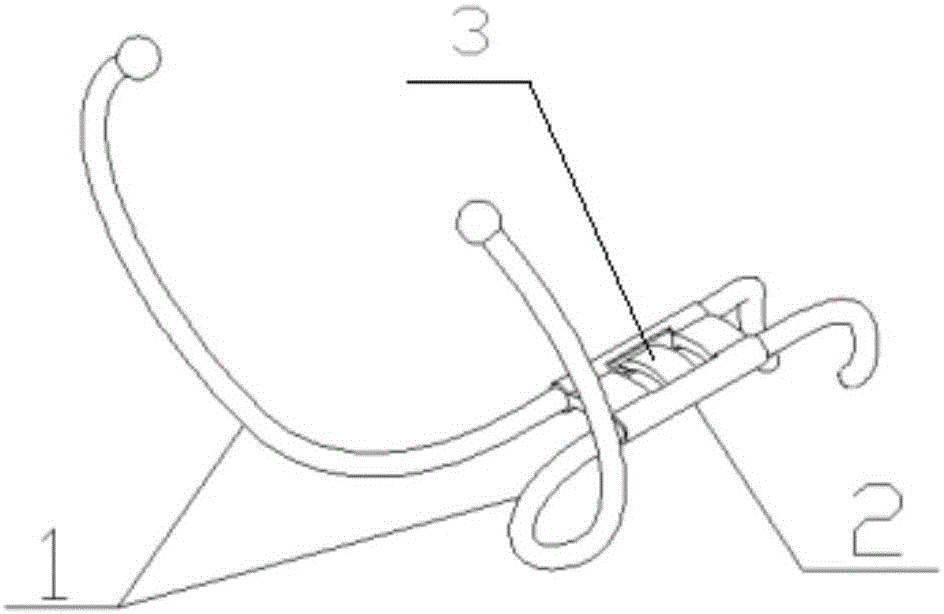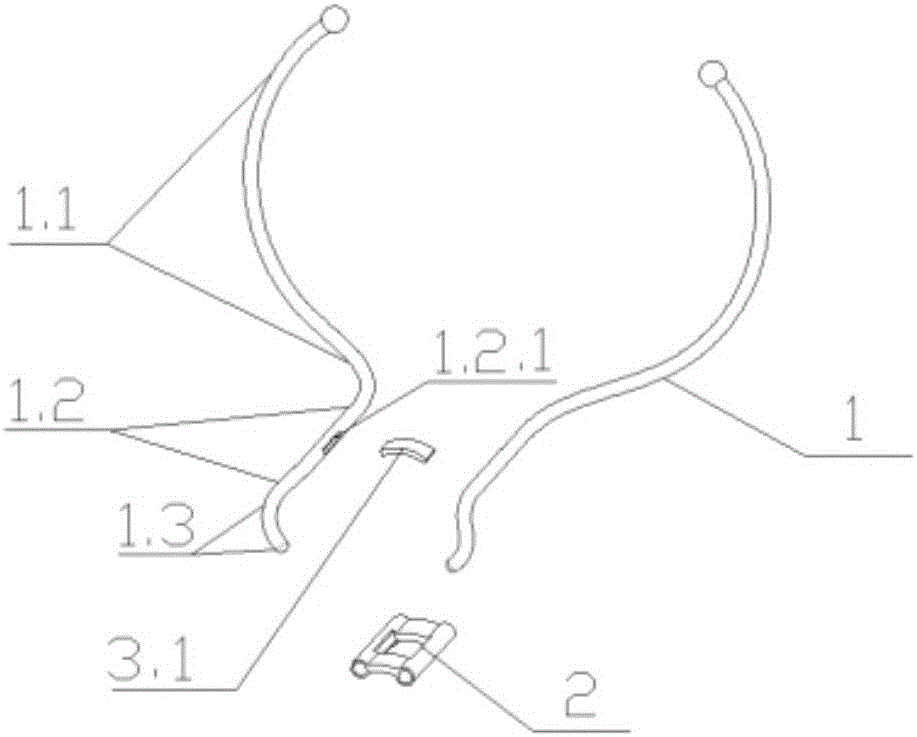Implantable urinary continence device
A urine device and implantable technology, applied in the field of medical devices, can solve problems such as difficulty in installation and urine control effects, drastic changes in shape, poor blood supply to the penis, etc., and achieve simple structure, small trauma, and daily Ease of use
- Summary
- Abstract
- Description
- Claims
- Application Information
AI Technical Summary
Problems solved by technology
Method used
Image
Examples
Embodiment 1
[0068] Such as Figure 1 to Figure 3 The implanted urination control device shown is composed of two device handles 1, a fixed block 2 and a device handle rotation angle limiting mechanism 3, and the two device handles 1 are respectively the first device handle and the second device handle. The instrument handle 1 is composed of a handle plectrum 1.1, a connecting shaft 1.2 and a urethral plectrum 1.3. One end of the connecting shaft 1.2 bends upwards to extend the handle plectrum 1.1, and the other end bends downwards to extend the urethral plectrum 1.3. The first instrument handle and the second instrument handle are mirror-symmetrically arranged, especially the part of the handle pick 1.1 and the connecting shaft 1.2 is symmetrical with respect to the central axis, the handle pick 1.1 is an arc-shaped structure extending to the side, and the terminal is inward Bending, the angle between the plane formed by the two handle picks 1.1 and the plane formed by the two connecting ...
Embodiment 2
[0071] Such as Figure 4 to Figure 8 The implanted urination control device shown is the same as that in Embodiment 1. The first device handle and the second device handle are arranged mirror-symmetrically, especially the parts of the handle paddle 1.1 and the connecting shaft 1.2 are symmetrical with respect to the central plane, and the handle The paddle 1.1 is an arc-shaped structure extending to the side, and the terminal is bent inward. The angle between the plane formed by the two handle paddles 1.1 and the plane formed by the two connecting shafts 1.2 is an obtuse angle of 110°. Moving the handle plectrum 1.1 can make the connecting shaft 1.2 rotate inwardly. The connecting shafts 1.2 of the two instrument handles 1 are sleeved in the communication hole 2.1 inside the fixed block 2 in parallel. The urethral plectrum 1.3 of the instrument handle 1 is an arc-shaped structure that bends to the side of the opposite side. The two urethral plectrums 1.3 are arranged in a fro...
Embodiment 3
[0073] Such as Figure 9 to Figure 11In the implanted urination control device shown, the rest of the first device handle and the second device handle are arranged mirror-symmetrically with the embodiment 2, especially the part of the handle dial 1.1 and the connecting shaft 1.2 is symmetrical with respect to the central axis, and the handle dial The piece 1.1 is an arc-shaped structure extending to the side, and the terminal is bent inward. The angle between the plane formed by the two handle paddles 1.1 and the plane formed by the two connecting shafts 1.2 is 120° obtuse angle, and it is moved inward. The handle pick 1.1 can make the connecting shaft 1.2 turn inward. The connecting shafts 1.2 of the two instrument handles 1 are sleeved in the communication hole 2.1 inside the fixed block 2 in parallel. The urethral plectrum 1.3 of the instrument handle 1 is also an arc-shaped structure bent sideways, and its terminal end is bent inward for clamping, but the urethral plectru...
PUM
 Login to View More
Login to View More Abstract
Description
Claims
Application Information
 Login to View More
Login to View More - R&D
- Intellectual Property
- Life Sciences
- Materials
- Tech Scout
- Unparalleled Data Quality
- Higher Quality Content
- 60% Fewer Hallucinations
Browse by: Latest US Patents, China's latest patents, Technical Efficacy Thesaurus, Application Domain, Technology Topic, Popular Technical Reports.
© 2025 PatSnap. All rights reserved.Legal|Privacy policy|Modern Slavery Act Transparency Statement|Sitemap|About US| Contact US: help@patsnap.com



